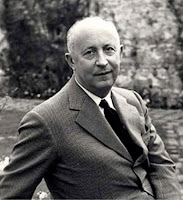French fashion designer Christian Dior revolutionized the fashion industry after World War II. Convinced that women were fed up with the uniforms and boxy, unadorned clothing of the war era, Dior launched his first fashion collection for Spring/Summer 1947 focusing on lady-like charm and feminine curves. He called his line "Corolle," after the botanical term for the frail petals at the center of a flower. However, it was Carmel Snow, the editor-in-chief of Harper's Bazaar, who coined the phrase "New Look." Excited and surprised by Dior's designs she exclaimed, "It's such a new look!"
Sloping shoulders, tiny waists, full busts and hips characterized the New Look. Skirts were below-mid-calf length, very full, and cinched at the waist. Busts and hips were also full, a look that had fallen out of favor in the 1920's and 30's. Wartime fabric restrictions were also a thing of the past by the time Dior created his own house of fashion in December 1946. The designer took full advantage of fabric availability by using yards and yards of extravagant material in his creations.
Over time, the New Look became popular and was embraced by women the world over, including many Hollywood stars of the day. Grace Kelly was especially fond of Dior's clothing. The New Look soon became synonymous with 1950's couture, and firmly replaced Paris as the capital of the fashion world after WWII.
In his 1954 book, The Little Dictionary of Fashion, Dior compiled an A-Z list on his favorite subject. In the Introduction he says, "Many people dismiss haute couture as being something that is only for those who are very wealthy. Simplicity, good taste, and grooming are the three fundamentals of good dressing and these do not cost money."
Christial Dior was born in 1905 in Granville, Normandy in a seaside town along the coast of France. As a young man, his parents strongly encouraged him to go into politics and wanted him to be a diplomat. He attended the Ecole des Sciences Politiques for five years, but during that time he made money selling his fashion sketches.
Eventually his love of design won out. He worked for various fashion houses until finally opening the House of Dior in 1946. Amazingly, Dior only lived to be 52. He passed away in 1957, while on vacation in Montecatini, of an apparent heart attack.
Dior's wildly influential decade in the fashion industry shaped other designers and trends for years to come. It's been said that he was a great believer in luck, attributing his success to "good luck." But looking at his gorgeous fashions, designs, style and know-how, it's obvious it was much more than that.






